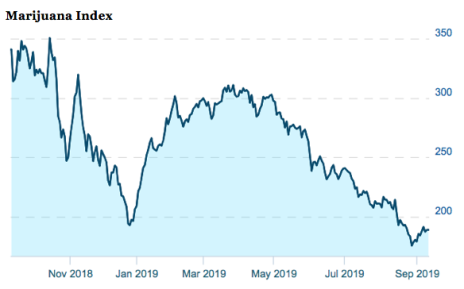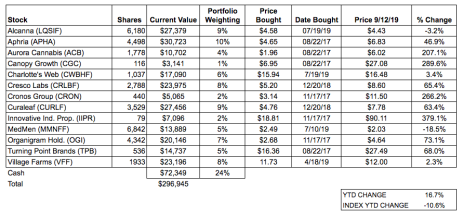One major factor in investing, particularly in small stocks and young sectors where growing pains are still the norm, is sentiment. Good sentiment can take a sector to extreme highs—as it has done for the marijuana sector at every major legalization milepost. And bad sentiment can take a sector to great depths, as it now threatens to do with some vaping stocks in the wake of the new vaping disease that is reported to have killed six people so far.
So today I start with my perspective on that.
The Truth About Vape Pen Lung Disease
The whole truth about vape pen lung disease is yet to be determined, but in light of the scary headlines I’ve been seeing recently, this seems like a good opportunity to bring you up to date on what I’ve been able to learn about this issue.
1. The disease is most likely due to contaminants or adulterants in black market vape cartridges.
2. The number one suspect is a thickening agent derived from vitamin E, known as vitamin E acetate.
These substances can be added to both nicotine and THC products, and for black market vendors, there’s little incentive not to—especially if it reduces costs.
In that way, this story is somewhat similar to that of bathtub gin nearly a century ago in the country, which occasionally had the potential to blind or kill people.
The long-term, solution, of course, is legalization and regulation—which begins in Canada in December (where no cases of the illness have been reported), but is still just a dream in the U.S.
In the meantime, the recent deaths and illnesses are prompting some people to call for a ban on vaping—and that’s just stupid.
For anyone buying legal vape cartridges—which have been sold for years in some states—there’s no more danger now than there ever was. And for people in states where vape cartridges are not legal yet, the remedy is to either return to smoking marijuana the old-fashioned way, or to buy vaping supplies out of state from a legal seller.
Hopefully, the authorities will recognize the real problem before the cries to ban vaping get too loud. If not, can I coin a new word—Vapegate?
The one big technical change in the past week is that Cabot’s intermediate-term market-timing indicator has once again turned positive for the general market, telling us trends are heading up. And cannabis stocks as well are looking better, as the Marijuana Index shows.
Odds are that this nascent uptrend will grow stronger—and I’m just beginning to think (though it’s foolish to predict) that this uptrend could peak in mid-December, when Cannabis 2.0 (the legalization of vapes and edibles) kicks in across Canada. But that’s getting ahead of ourselves.
Investing Strategy
Still, it’s worth keeping in mind the long-term goal. Long-term, we want to be owners of the stocks that will lead this industry five and 10 years from now. But we don’t want to own them all the time! So a key part of my strategy is to overweight stocks that are going the right way and underweight stocks going the wrong way.
In your own portfolio, remember to reward good behavior and punish bad behavior. Average up. Never average down.
Our Stocks
Moving on to our stocks, trends are improving—but not everywhere, so selectivity remains important.
Interestingly, a review of the portfolio this week revealed that three of our stocks have achieved one of my favorite fundamental milestones, which is accelerating revenue growth, and they are Aphria (APHA), OrganiGram (OGI) and Innovative Industrial Properties (IIPR). That’s one more thumb on the scales for those stocks.
What To Do Now
The portfolio comes into today roughly 24% in cash, but by putting money back into the stocks that deserve it, we will now take that cash level down to about 13%. The portfolio will now sell half of its position in Turning Point Brands (TPB) but average up in Cronos (CRON), Curaleaf (CURLF) and OrganiGram (OGI). Details on all the stocks below.
Alcanna (LQSIF) The portfolio’s most recent addition, Alcanna is up 20% since its low two weeks ago, but the portfolio is still under water, having bought too high. Still, the stock is going the right way, and it’s cheap! Of course, it’s also the most thinly traded stock in the portfolio by a wide margin, so volatility is to be expected. If you haven’t bought yet, wait for a pullback.
Aphria (APHA) Aphria is now the largest producer in Canada, as well as the portfolio’s largest position coming into today—though that will change with today’s actions. (We’re not cutting APHA, but adding stakes in three others.) The portfolio averaged up a month ago, but if you haven’t bought yet, you can buy here. The stock is above both its 25- and 50-day moving averages and working to break out of a basing formation centered on 7.
Aurora (ACB) The portfolio has been underweight ACB because the stock has been expensive and the chart has been quite weak, bottoming—perhaps—just two weeks ago. Then, last night the company released its fiscal fourth-quarter results, and investors were disappointed—dropping the stock about 10% this morning—so it appears we’ll stay underweighted for longer, even though the results boosted the company into the number two position in Canada. Instead of the expected revenues of $108 million, revenues were $99 million (up 413% from last year). On the plus side, instead of the expected loss of six cents per share, the loss was just four cents—or only a penny if subsidiaries aren’t counted.
Canopy Growth (CGC) Canopy has lost its crown. The search for a new CEO continues. And investors have not yet been able to turn this chart up, in part because the stock still appears expensive. The portfolio has been underweight CGC since mid-April and two weeks ago I took our weighting down to 1%. Long-term, of course, Canopy has its plan to buy U.S. multi-state operator (MSO) Acreage Holdings once marijuana becomes legal across the U.S., and big shareholder Constellation Brands should help as well when the Canadian cannabis beverage market takes off. But for now, the tide is still going out.
Charlotte’s Web (CWBHF) Colorado-based Charlotte’s Web is America’s biggest seller of CBD, with more than 8,000 retail locations, and the company has been reporting positive earnings since 2017. The portfolio sold half its position in CWBHF on August 5, the last day of a very strong eight-day advance—and bought back in last week. If you haven’t bought yet, you can buy here, while the stock sits on its 200-day moving average at what looks like the end of a normal correction.
Cresco Labs (CRLBF) The third-largest MSO in the U.S., Cresco is growing at a good pace, and the chart looks solid above both its 25- and 50-day moving averages. The portfolio averaged up one month ago at 8.8 and is now slightly overweight. If you don’t own it, you can buy here.
Cronos Group (CRON) I’ve been anti-Cronos for a while—and thus underinvested in the stock—because of valuation concerns based on revenues. But as I begin to look at earnings as well—because more and more of these companies are on the verge of making profits—CRON is looking like a “less-worse” value. Plus, the long-term chart shows the stock at what looks like a decent low-risk buying point. The portfolio last took profits in April at 15.8 and will now buy back in, doubling our position size. If you haven’t bought, you can buy here. Also, don’t forget that Altria owns 45% of the company.
Curaleaf Holdings (CURLF) Curaleaf is the strongest marijuana stock in the portfolio, as more and more investors come to see it as the king-of-the hill in the U.S., at least for now. Analysts expect positive earnings in both 2019 and 2020. The portfolio bought back in a month ago at 7 to become overweighted again, and that’s worked out well, so now we’ll pile on a little more, adding 50% to the position—which will make it our largest holding.
Innovative Industrial Properties (IIPR) The only publicly traded REIT focused on the cannabis industry, IIPR has been a big winner for us, but since mid-July the stock has been cooling off, following the cannabis sector down. The portfolio has taken profits twice since June, so is well underweight, and there’s a temptation to buy back in here, with the stock just bouncing off its 200-day moving average and with parts of the REIT sector looking stronger. But I’m going to give it a little more time; I don’t really see any volume in the buying yet.
MedMen (MMNFF) MedMen, one of the leading MSOs in the U.S., is the portfolio’s biggest loser, but the loss is tolerable, so far. The stock is “cheap” on a revenue basis, and the stock seems to be building a bottom at 2.0, but the fact that analysts don’t see earnings until 2021 is beginning to worry me.
Organigram (OGI) Earnings prospects are very good for this second-tier Canadian producer, thanks to efficient growing technology and cost controls. The company has reported positive adjusted EBITDA for the last four quarters in a row, and looking ahead, analysts are expecting a profit of $0.06 per share in 2019 and $0.16 in 2020. The portfolio took profits at 6.2 last October when the Canadian cannabis stocks peaked and then again at 6.4 in June as they all swooned, but last week, after OGI had became deeply oversold—hitting a low of 4—and rebounded, the portfolio averaged up. And this week I’m going to pile on more, doubling our position again.
Turning Point Brands (TPB) Turning Point Brands is the old-school smokeless tobacco company that’s been transitioning into the cannabis business successfully; it posts earnings every year and it pays a dividend! But the stock looks terrible, almost certainly because the company’s greatest growth prospects were in its vaping assets (Vapor Supply, Vaporfi, Vaporshark and Vaporbeast) and vape is now a four-letter word. It’s tempting to say the selling is overdone, but it’s more prudent to listen to the message of the stock and remember that trends can and often do go to extremes. The portfolio will now sell half its position.
Village Farms International (VFF) Village Farms International is the Canadian greenhouse grower of tomatoes, cucumbers and peppers that’s diversifying into marijuana (in Canada) and hemp (in the U.S.). It doesn’t pay a dividend, but analysts are expecting earnings of $0.68 per share in 2019 and $0.81 in 2020. The stock is now above all its moving averages, but ripe for a small correction, so if you haven’t bought yet, you could wait a while.



